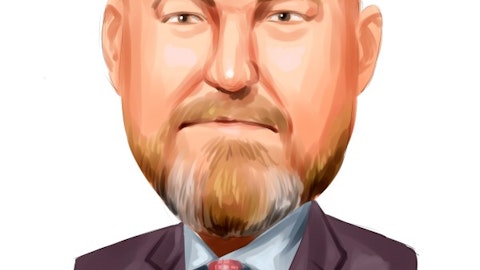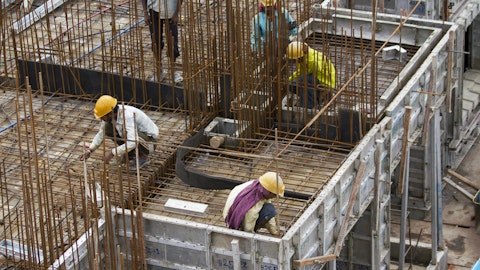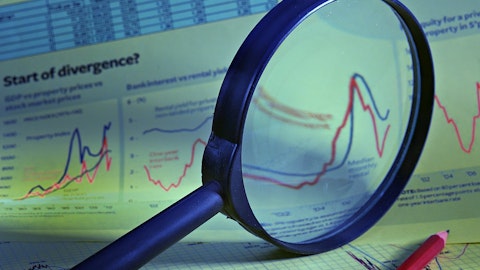CEMEX, S.A.B. de C.V. (NYSE:CX) Q4 2022 Earnings Call Transcript February 13, 2023
Operator: Good morning, and welcome to the CEMEX Fourth Quarter 2022 Conference Call and Webcast. My name is Daisy, and I’ll be your operator for today. At this time, all participants are in a listen-only mode. Later, we will conduct a question-and-answer session. And now, I will turn the conference over to Lucy Rodriguez, Chief Communications Officer. Please proceed.
Louisa Rodriguez: Good morning. Thank you for joining us today for our fourth quarter 2022 conference call and webcast. We hope this call finds you in good health, and let us take this opportunity to give you our best wishes for 2023. I’m joined today by Fernando Gonzalez, our CEO; and Maher Al-Haffar, our CFO. As always, we will spend a few minutes reviewing the business, and then we will be happy to take your questions. And now I will hand it over to Fernando.
Fernando Gonzalez: Thanks, Lucy, and good day to everyone. 2022 was a year of unexpected challenges for many businesses, as inflation spiked to 40-year highs. I’m pleased with how we responded and expect to continue to see the benefits of our strategy in 2023. Now let’s move to the fourth quarter. Our top line growth grew double-digit driven by strong pricing performance. EBITDA was higher in three of our four regions. In fact, the U.S. reported record fourth quarter results. As you know, our top priority has been to recover 2021 margins. Importantly, after several quarters in which we have been able to offset inflation in dollar terms, I’m seeing growing evidence that actual margin recovery is underway. We continue to roll out our growth investment strategy with the recent announcement of the acquisition of Atlantic Minerals, which will increase our U.S. aggregate reserves by approximately 20%.
The growth strategy has proven to be quite accretive with an approximately $100 million contribution to EBITDA in 2022. We continue our work on rebalancing the portfolio with divestments of more than $600 million during the year. Achieving an investment-grade rating remains a top priority. During the quarter, Standard & Poor’s upgraded our rating to BB+, one notch away from investment-grade. In Climate Action, we led the industry in validating our new 2030 targets and 2050 net zero goals with the SBTi under the newly announced 1.5 degree scenario. And even more importantly, we continue to achieve record reductions in CO2 emissions. Since we introduced our future in Action program in 2020, we have reduced emissions by 9% to date. We continue to explore new ways to take our existing decarbonization levers even further in our sustainability journey.
During the quarter, we launched our new business, Regenera, which is devoted to waste management and circular solutions and the latest addition to our Urbanization Solutions segment. Net income after adjusting for a non-cash impairment of goodwill rose 36%. Finally, our return on capital remains in the double digit area, well above our cost of capital. For the full year, net sales rose double-digit due to strong pricing momentum. With the sudden spike in inflation in second quarter attributable to energy and distribution costs and exacerbated by supply chain disruptions stemming from the Ukraine war, margin declined by 2.5 percentage points. Largely due to our effective pricing strategy, we were able to contain the impact on EBITDA to a 3% drop.
Free cash flow after maintenance CapEx declined due primarily to working capital and maintenance. Fourth quarter sales growth continued to reflect significant pricing contribution of all regions. Inflationary headwinds particularly in energy were significant, but our year-long effort to offset rapid rising cost is paying off with stable year-over-year EBITDA. While EBITDA margin declined, the contraction was the lowest of the year and sequential margins stabilized in the quarter where we historically see a significant decline due to seasonality. As is typical for fourth quarter, we experienced strong free cash flow conversion, generating close to $60 million more than the prior year. The decline in fourth quarter consolidated cement volumes results from difficult weather conditions in the U.S., weak back-cement demand in Mexico and SCAC and slowing growth in Europe.
We continue to see strong growth from the formal sector in Mexico and SCAC, but not sufficient to completely offset the informal sector decline. Consolidated prices accelerated in fourth quarter with cement prices rising between 12% and 35% across all regions. Europe remains the standout performer with price increases that have been able to compensate for much of the margin pressure. The 2% sequential growth in consolidated prices speak to the strength of our fourth quarter price increases executed in select markets. We are implementing price increases in the first quarter that will reflect the cumulative input cost inflation we have experienced across our portfolio. I am pleased that the January price increases covering more than 70% of our volumes are evolving well despite weaker demand dynamics in some markets.
Pricing, however, is not the only lever, and we remain focused on managing costs with our energy diversification, supply chain and climate action strategies. The decline in EBITDA continues to be largely explained by a lower margin caused by persistent input cost inflation. We are seeing an important inflection point, however. In fourth quarter, the net contribution of pricing over cost was the highest in the year. The evolution of the net price contribution as well as the outperformance of fourth quarter year-over-year margins versus full year gives me confidence margin recovery is happening. In our effort to recover margins, we monitor progress on a product basis. Cement, due to its energy intensity has been the product most impacted by inflation and the biggest headwind to margins.
Since second quarter, we have successfully offset input cost inflation in cement in dollar terms. By the fourth quarter, we began to see actual margin recovery. EBITDA margin for cement reached its highest level in the year driven by the U.S. and EMEA. We still have work to do to return to 2021 margin. In 2023, with easing cost pressures and pricing momentum, I expect to see further margin improvement, particularly in the second half. Progress, however, will not be linear due to seasonality and timing differences on maintenance and pricing increases. This has been another important year in our sustainability efforts. CEMEX was among the first companies in our industry to receive validation from the Science-Based Target initiative of our 2030 and net zero CO2 goals under the 1.5 degree scenario, the most aggressive pathway for our industry, covering Scope 1, 2 and 3 emissions.

yuttana Contributor Studio/Shutterstock.com
But it is not about goals, it’s about performance. And in that regard, CEMEX has also delivered. In the two years since we first rolled out our sustainability program, Future in Action, we have achieved a record reduction in carbon emissions driven largely by an expansion in alternative fuel usage and a lower clinker factor. During this period, our CO2 emissions declined by more than 9%, a reduction that in the past, took more than a decade to achieve. This is equivalent to the annual emissions of approximately 700,000 cars that run on gasoline. In 2022, alternative fuels hit a record 35% of total fuels usage. The introduction of innovative hydrogen technology in more than 40% of our plants accelerated our progress. Record alternative fuels is occurring at an opportune moment and serves as an important hedge to elevated fossil fuel prices.
Clinker factor declined 1.5 percentage points, opening up capacity in highly constrained cement markets. Critical to our journey is customer acceptance. And in three short years, our Vertua family of sustainable products and solutions has gained widespread acceptance across all regions. Vertua sales now account for 41% of cement volumes and 33% of our concrete sales. As I watch CEMEX transform, I am more convinced than ever that our products are essential to society, our goals are achievable and the path to get there is profitable. Over the last three years, our Urbanization Solutions business has been focused on the products and services to serve the needs of growing sustainable cities of the future. It includes four verticals and one of these verticals, circularity, received a big push in fourth quarter with the launch of our new business, Regenera.
Regenera will focus on recovering, managing, recycling and co-processing three waste streams: first, municipal and industrial; second, construction, demolition and excavation waste; and finally, third, byproducts of industrial processes. The business will leverage CEMEX global footprint and our more than 20 years of experience in managing non-recyclable refuse and industrial pipe products as well as identifying more sustainable substitutes for fossil fuels and natural raw materials. We are already making big strides. For example, in Mexico, we are processing around 25% of Mexico City’s municipal waste. And on a global basis, we are recovering municipal waste equivalent to the combined annual total produced by the cities of Paris and Berlin.
And now back to you, Lucy.
Louisa Rodriguez: Thank you, Fernando. 2022 brought new challenges for our Mexican operations. Our business experienced significant cost pressures, mainly in the form of higher fuel and distribution costs, coupled with a post-pandemic rebalancing of bagged cement volumes. While pricing increases were some of the highest on record, it was still not sufficient to recoup margins. In fourth quarter, with continued inflation pressuring retail demand, bagged cement volumes moderated while bulk cement grew high-single digits. The formal sector benefited from near-shoring investments in border states, tourism construction and distribution and logistics activity in the central part of the country. As our pricing strategy continued to make inroads in catching up to inflation, year-over-year EBITDA rose for the first-time in five quarters.
While margins declined due to higher energy, raw materials, freight and wages as well as product mix, the decline moderated versus full year performance. We remain committed to recovering margins. And with that objective, we announced price increases for all of our products effective January 1. As part of our cost containment and decarbonization efforts, we have moved aggressively in Mexico to substitute fossil fuels with alternative fuels for our accounts. In the quarter, alternative fuels exceeded 40%, a record, representing a 12 percentage point year-over-year increase. For 2023, we expect cement volumes to remain flat while ready-mix and aggregates grow at mid and high-single digits, respectively. The industrial and commercial sector, driven by near shoring and tourism should remain the driving force behind 2023 volumes, while government social programs should help offset continued weakness in household demand.
In the U.S., despite significant weather challenges impacting much of our markets, EBITDA grew mid-teen percentage points to a record fourth quarter result. Growth was fueled by price gains in excess of 20% that more than offset lower volumes. We estimate that weather impacted EBITDA by approximately $18 million in the quarter. Year-over-year EBITDA margin expanded for the first-time since early 2021, while sequential margins also improved for the second straight quarter, benefiting from higher prices, lower maintenance and lower imports. Full year EBITDA was driven by mid-teen percentage point growth in pricing and low-single digit volume growth. We remain focused on regaining margins lost due to the significant levels of inflation of the past year.
We announced a price increase effective January 1, and to-date, we are seeing good traction. In January, we signed an agreement to purchase Atlantic Minerals Limited in a transaction that will expand our U.S. aggregate reserves by 20%. We expect this deal to close shortly and to be accretive in 2024. For 2023, we expect low-single digit volume decline across all products, driven by the residential sector. We remain optimistic on growth in industrial and commercial and infrastructure sectors, underpinned by near shoring trends along with funding available under the CHIPS Act, the Inflation Reduction Act and the Infrastructure Investment in Jobs Act. As of December, trailing 12-month contract awards in our key states for highways and street and industrial and commercial were up 16% and 29%, respectively.
In EMEA, sales and EBITDA grew double-digit in 2022. In fourth quarter, while sales continued to show strong growth driven by pricing, EBITDA growth slowed due primarily to energy costs, declining volumes and higher maintenance. Pricing remained strong with sequential increases in cement and ready-mix, reflecting fourth quarter price increases in several markets. Europe showed strong cement pricing traction with a 5% sequential increase and 35% year-over-year growth. We are in the process of executing additional price increases, which will roll out over the next few months. In Europe, EBITDA growth of 9% in fourth quarter largely reflected our pricing efforts while volumes declined as a result of recessionary fears. Margin declined by less than 1 percentage point due primarily to energy costs.
During the year, our European operations continued to lead the way on climate action, achieving a 41% reduction in carbon emissions since 1990. The region is well on its way to achieving the EU emissions reduction target of at least a 55% decline by 2030. For 2023, we expect cement volumes in Europe to decline mid to high-single digit, with ready-mix volumes falling low to mid-single digits and aggregates volumes relatively flattish to down. Over the medium term, volumes should be supported by public and private projects worth more than EUR2 trillion related to transportation, climate adoption and energy reconfiguration as well as onshoring investment opportunities. In the Philippines, cement volumes declined as the country transitions to a new government and macro challenges impact demand.
Margin was impacted primarily by higher energy costs and major maintenance. For this year, we expect volumes to perform between flat and a low-single digit decline. For more information, please see our CHP quarterly earnings, which will be available this evening. Our operations in Egypt and Israel continued to show strong top line and EBITDA growth. For Israel, while demand remains robust, we expect ready-mix and aggregate volumes to decline low-single digit, reflecting our capacity constraints. Net sales in our South, Central America and the Caribbean region slowed in fourth quarter. Pricing remained the driver of top line growth with cement prices up 12% year-over-year. Similar to Mexico, cement volumes in the region have been pressured by the rebalancing of bagged cement post-pandemic.
Bulk cement, ready-mix and aggregate volumes continue to grow, supported by formal sector demand, mainly in the industrial and residential sectors. The decline in EBITDA and EBITDA margin reflects energy, freight and raw materials cost headwinds. In Colombia, cement volumes rose slightly in the quarter, driven by social housing. For 2023, we expect cement volumes in Colombia to be flat while ready-mix volumes to increase high-single digit. Construction activity should continue to be supported by social housing and infrastructure projects, particularly in the Bogota area. In the Dominican Republic, cement volumes declined in the quarter due to a drop in retail cement demand that was partially offset by higher bulk cement related to tourism projects.
For the year, we expect cement volumes in the Dominican Republic to remain flat to slightly down. Activity should be supported by tourism and industrial investments. In Panama, we continue operating as an export hub, sending record cement volumes to nearby markets within the region, reducing dependency from third-party suppliers. I invite you to review CLH’s quarterly results, which were also published today. And now I will pass the call to Maher to review our financial developments.
Maher Al-Haffar: Thank you, Lucy, and good day to everyone. As we all saw, financial markets experienced unprecedented volatility, with inflation reaching levels not seen in decades and central banks implementing monetary tightening measures globally. In our industry, this volatility played out largely in the form of rising energy and transportation costs as well as continued supply chain disruptions. Our pricing and energy hedging strategies were able to offset much of the inflationary impact. Of course, this is an ongoing effort, and you should expect continued execution of our pricing strategy in 2023 to regain our 2021 margins. Additionally, we remain focused on several initiatives to improve efficiency and lowering the cost of managing our business.
The stable year-over-year EBITDA in the quarter, the first in three quarters, speaks to the success of our pricing strategy. The improving EBITDA trend, coupled with a higher turnaround in working capital and lower maintenance CapEx, delivered approximately $60 million more in free cash flow after maintenance CapEx than last year’s fourth quarter. On a full year basis, free cash flow after maintenance CapEx was $553 million, down from the prior year due to a higher investment in working capital and maintenance CapEx. The investment in working capital reflects strong revenue growth and the inflationary impact on inventory, as well as the need to run higher inventories to address persistent supply chain issues. On the collections front, the credit quality and the turnover efficiency of our receivables are at record levels, leading to a significant improvement in our receivables collection cycle.
The increase in maintenance CapEx for the year relates primarily to some catch-up maintenance as well as the delayed delivery of mobile equipment and spare parts in 2021, which pushed our maintenance calendar into 2022. The decline in quarterly net income results from the non-cash impairment of goodwill for $365 million, primarily in the U.S. and Spain. Adjusting for this impairment, net income for the quarter would have been $266 million, 36% higher than last year’s fourth quarter. Last year, we took advantage of market volatility to conduct several accretive transactions. We bought back about $1.2 billion of our bonds at an attractive discount, resulting in an NPV of approximately $160 million. We partially funded these bond purchases through the closing of a EUR500 million sustainability linked loan with similar terms and conditions as our current bank credit agreement.
Overall, we reduced total debt by $409 million during the year. Also, we maintained robust risk management strategies that in 2022 partially shielded us from the impacts of rising interest rates, a stronger dollar and higher energy costs. As a consequence and despite market volatility, our leverage ratio stood at 2.8 times, relatively flat to December 2021. In 2022, we further aligned our funding strategy with our Climate Action agenda. During the year, we linked our new EUR500 million loan and migrated our accounts receivable securitization program to our sustainable finance framework. This is, of course, the same framework linked to our umbrella $3.5 billion credit agreement. The price under these programs will now be indexed to certain sustainability KPIs. With the inclusion of these programs, we now have approximately 42% of our debt linked to sustainability KPIs, and we remain on track to reach our goal of 50% by 2025 and 80% by 2030.
We will continue to undertake strategies that bolster our capital structure and remain focused on achieving investment grade in the short term. With the recent upgrades from S&P and Fitch, we are now only one notch away from our goal. And now back to you, Fernando.
See also 13 Stocks Big Short Michael Burry is Buying and Selling and 10 Jim Cramer Stocks This Month.
Q&A Session
Follow Cemex S A B De C V (NYSE:CX)
Follow Cemex S A B De C V (NYSE:CX)
Fernando Gonzalez: We expect low-single digit growth in EBITDA in 2023, as we assume continued pressure on volumes due to global recessionary concerns. While we acknowledge moderate risk to volumes, we believe that markets will remain supportive of pricing. We do expect continued headwinds on cost, particularly in electricity, but the impact should be less than what we experienced in 2022. Energy cost per ton of cement produced is expected to ease, estimating a 10% increase for this year. Our efforts to recover to 2021 margins will continue. And while I expect progress, it will not always be linear. Total CapEx is expected to be lower than the prior year at approximately $1.25 billion. We continue to expect an investment in working capital in 2023, reflecting the higher sales but overall days working capital should improve.
Cash taxes are expected to increase by approximately $50 million. Finally, our cash cost of debt, including the coupons of our subordinated notes is expected to increase around $70 million, reflecting the repricing of our limited floating rate debt exposure. As always, our guidance is based on like-to-like assets as well as the foreign exchange at the time of guidance. And now back to you, Lucy.
A – Louisa Rodriguez: Before we go into our Q&A session, I would like to remind you that any forward-looking statements we make today are based on our current knowledge of the markets in which we operate and could change in the future due to a variety of factors beyond our control. In addition, unless the context indicates otherwise, all references to pricing initiatives, price increases or decreases refer to prices for our products. And now we will be happy to take your questions. And the first question comes from Carlos Peyrelongue from Bank of America. Carlos, please go ahead.
Carlos Peyrelongue: Thank you, Lucy. Good morning, Fernando and Maher. My question is on costs. On your total costs COGS (ph) plus SG&A, what is the most relevant energy input cost? Is it diesel or pet coke? And can you comment last year what percentage of these two costs were hedged just to get a sense of the impact for this year? Thank you.
Maher Al-Haffar: Yes. Thank you, Carlos. I’ll take that question. In terms of fuel and electricity last year, about $1.7 billion or 12% of our COGS were represented by that. And as you know, we have a guidance of 10% growth for the year in that. Most of that is due to electricity. In fact, 90% of that is due to electricity. Now just to put it into perspective, diesel compared to the $1.7 billion was around $340 million or 2% of COGS. Now in the case of diesel, we currently have about 75% hedged for 2023. And so, we may get a little bit of a higher cost because of the hedging activity that we did towards the second half of last year. But on the pet coke side, that is predominantly a spot market. And so we should be benefiting from the important drop in the price of pet coke from the — towards the third and fourth quarter of last year. I hope that answers your question, Carlos.
Carlos Peyrelongue: It does. Just one quick follow-up. On the hedge you deal on diesel, was that primarily done in the fourth quarter or second half of last year?
Maher Al-Haffar: It was probably done closer to the fourth quarter.
Carlos Peyrelongue: Perfect. Great. Yeah, that does. Thank you so much, Maher.
Maher Al-Haffar: Thank you very much, Carlos.
Louisa Rodriguez: And the next question comes from the webcast from Paul Roger from Exane BNP Paribas. Do you expect the 5% rate reduction to accelerate in coming years as new technologies play a role or could it get harder if a lot of the conventional solutions have already been widely adopted? And as a follow-on to that, what were the most exciting developments in the CEMEX Ventures portfolio last year?
Fernando Gonzalez: Thanks for your question, Paul. On the first part on CO2 reduction, maintaining or accelerating the ratio that we managed to reduce close to 5% in ’22 and also in ’21. Let me start by clarifying that the reductions that we have been making and the ones related to our CO2 reduction targets are related to what you’re calling conventional technologies or conventional processes or material. So in these numbers, we are not including the benefit of potential CO2 reductions because of CO2 capture and storage or use, which might come through time because of the type of pilots that we are developed or developing as we speak. But on the conventional part, the 5% for a couple of years, I think the — we took opportunities that were there and speeded up the process in order to make them a reality.
If we refer to the public targets we have, just to use one example, on CO2 reduction, we have a target of in ’25 of 520 kilos per CO2. So when comparing to the 2022 reported data, that’s a reduction of 9%, which implies a reduction of 3% per year, meaning we are expecting that these 5 percentage points of reduction will start little by little, declining and they will remain for the whole period from now or from ’23 up to 2030 in the range of 3% to 3.5%. That will do — that will allow us to comply with commitments. And perhaps in 2025, they will allow us to complete them even before that date or to exceed those targets in that date. Now another clarification that I would like to make is that the conventional ways to reduce CO2, it happens that there are — there is innovation in those conventional ways, improving or increasing the impact that they historically had, for instance.
The use of certain amounts of hydrogen in the plants using high levels of RDF waste as a few, it’s been working very well. So as reported in the last quarter of last year and for the first time in history, we had as much use of alternative fuels when compared with what has been our principal source of fuels, which is pet coke. And considering just the month of December, that proportion for alternative fuels is even higher. So I think in ’22, ’23, we are witnessing the milestone of alternative fuels becoming the principal source of fuel in our plants with all the advantages, advantages in cost, they got less than half of our primary fuels, benefits in terms of contribution to participating in the use of and recovering waste. As we have commented before, we are taking care of 25% of waste of Mexico City, and we use most of that in our plants as fuel.
In the case of Europe, which last year, we — even though we had a large proportion of alternative fuels, we increased it for another 8 percentage points. Nowadays, we are consuming the equivalent of waste of a city like Berlin. So there are many advantages. We continue doing progress. ’22, we increased our use of alternative fuels in 6 percentage points. And for the target we have in ’25 is an additional increase of 5 percentage points in three years. So I think the reduction will start — we will see start seeing a reduction moving from the 4.5%, 5% to the range of the 3% to 3.5% until we are ready to commit with reductions because of CO2 capture. On the second part, exciting developments. I think what excites me or what excites us is not necessarily one particular event, and I will mention one or two, but I think what excites us is to see how CEMEX Ventures is allowing us to attract and to invest and to integrate a number of different technologies that nowadays have to be integrated into our cement plants.
I’m referring, for instance, of this idea of small injections of hydrogen in our plants. Nowadays, more than 40% of our production have this type of hydrogen injection. I’m referring to the possibility of electrifying more the changes in process like electrifying the process itself, so in order to use more electricity and less fuels, other processes, completely different processes to produce cement or the process that we announced through our partnership with Synhelion, meaning to produce clinker now that it is feasible to concentrate solar energy into very high temperatures, the ones needed to produce clinker. But what I see is that we have a very large map of different technologies that we think will be integrated into cement production or distribution and that’s what we are excited.
We are having a very good response and interest in the cost to take world, and that is moving forward. We just announced, for instance, availability of the first full electric ready-mix truck that can work all day long with its battery produced by . It wasn’t a sort of agreement we made two years ago. So we are very happy with all those advances and they make us believe that we will continue delivering in our commitments.
Louisa Rodriguez: Thank you, Fernando. And the next question comes from Ben Theurer from Barclays. Ben?
Benjamin Theurer: Yeah. Good morning, Lucy. Thanks for Fernando and Maher. My one question would be on the pricing traction, what you’re seeing and how you think about pricing initiatives for 2023, particularly in key markets like the U.S. and Mexico. Any comment you have on the recently announced increases and how we should think about pricing throughout the year to offset these 10% cost headwinds? Thank you.
Maher Al-Haffar: Yeah, Ben. Maybe I’ll take a stab at that. We’re coming in from a very healthy pricing environment, albeit and you saw the results, the pricing contribution to our EBITDA for the year and certainly for the quarter has been in excess of inflation. However, we continue with our pricing strategy because the inflation acceleration has been much higher than our ability to raise prices. And that’s part of the reason why we saw an EBITDA margin erosion. So there’s definitely — the job is not done, completed yet on the pricing strategy. We continue to accelerate. Now the good thing about this is that we’re coming in with good momentum. We have tailwinds of about 5% coming into — assuming the December ’22 prices in local currency terms.
And this assumes no additional increases, okay? Now having said that, we’ve seen very good evolution of pricing increases in all of the markets. More than 80% of our volume is being repriced. So just to give you an idea, for instance, Mexico, we have a pricing increase, double-digit 15% to 20%. In the U.S., we have a high-single digit increase in January, March. We have double-digit increases, mid to high-teens in several of our European markets, Spain, Poland, Czech Republic, Croatia. The Philippines is also experiencing a pricing increase in January, March. Double-digit increases in Colombia, in the high-teens, 20% range. And the story goes on. I mean essentially, more than 80% of our volume is being repriced in the early part of the year and we think that there is very good traction.
In Europe, a very important part of the pricing pressure on everybody is the continued pressure on the price of carbon, and so that’s a very important part of inflation there. But we’re optimistic. I mean, we think that this momentum should continue despite a little bit of a backdrop of slower demand in some of the markets that we’re operating in. I don’t know if that answers your question.
Benjamin Theurer: Perfectly. Yeah. Thank you.
Maher Al-Haffar: Great. Thank you very much.





